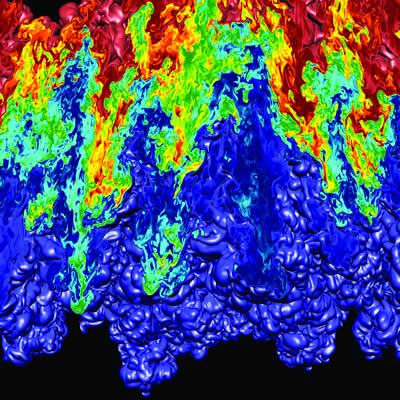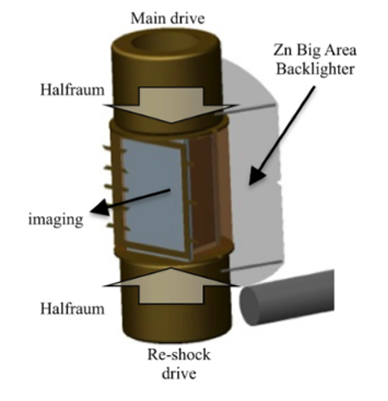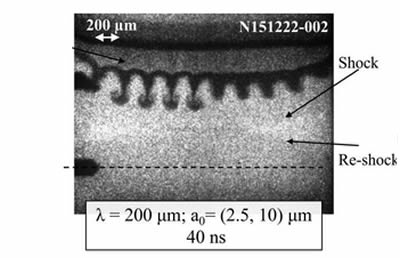Papers and Presentations - 2017
July
Getting a Better Handle on Implosion Instabilities
LLNL researchers have developed a new NIF experimental platform to probe the inner workings of hydrodynamic (fluid) instabilities that play an important role in situations ranging from inertial confinement fusion (ICF) implosions to the death throes of collapsing stars.
In a Physics of Plasmas paper published online on July 5, the researchers said NIF, the world’s largest and highest-energy laser system, has the ability to drive hydrodynamic instabilities to experimental regimes not previously accessible.  A Rayleigh-Taylor instability simulation conducted on LLNL’s BlueGene/L supercomputer. This capability will likely enable important new insights into how these instabilities develop in plasmas in order to constrain theoretical models.
A Rayleigh-Taylor instability simulation conducted on LLNL’s BlueGene/L supercomputer. This capability will likely enable important new insights into how these instabilities develop in plasmas in order to constrain theoretical models.
Rayleigh-Taylor (RT) and Richtmyer-Meshkov (RM) instabilities occur when fluids of different densities are accelerated together (RT) or shocked (RM) and begin to interpenetrate at their boundary. The signature of the RT instability is a “bubble” and “spike” structure, in which fingers of dense material (spikes) interpenetrate the less dense fluid (bubbles), leading to a mixture of the layers of fluid.
This can occur at the contact surfaces in exploding supernovas—the rate of growth of the mixing region is thought to be a controlling factor in the rate of formation of heavy elements—and it also plays a role during multiple phases of ICF capsule compression, where accurate prediction of the depth of interpenetration of fluids is crucial in designing capsules to maintain shell integrity.
In an ICF experiment, RT and RM instabilities can occur during two distinct phases of the implosion—as the hohlraum x-ray drive accelerates the material in the outer layers (the ablator) of the target capsule into the fusion fuel inside the capsule, and when the shock front “rebounds” from the target’s center and moves back through the capsule in the opposite direction.  Depiction of a shock tube target with the drive halfraums (half hohlraums) and zinc big area backlighter. Instability growth during either the acceleration or deceleration phases of an implosion can lower ICF capsule performance by substantially degrading the ablator’s ability to compress the fusion fuel and by mixing ablator material into the fuel.
Depiction of a shock tube target with the drive halfraums (half hohlraums) and zinc big area backlighter. Instability growth during either the acceleration or deceleration phases of an implosion can lower ICF capsule performance by substantially degrading the ablator’s ability to compress the fusion fuel and by mixing ablator material into the fuel.
To gain a better understanding of these instabilities, LLNL researchers adapted the target drive and diagnostic configuration of a related NIF campaign led by Los Alamos National Laboratory studying high energy density shear flows (see “Shock/Shear Experiments Shed Light on Turbulent Mix”) with an additional technological ingredient: long fiber delays on the backlighter beams that enable radiographic imaging at times later than 35 nanoseconds after the experiment starts (35 nanoseconds is the maximum delay for the standard NIF beam configuration; see “Automating NIF Beam-Timing Delays”).  Radiographic image of a NIF implosion at 40 nanoseconds showing the nonlinear spike-bubble pattern of hydrodynamic instability, with the spikes displaying the characteristic “mushroom cap” structure. The sinusoidal perturbation wavelength λ=200 microns with initial amplitudes a0=2.5 microns and 10 microns. The capability of probing at late times is essential for studying the nonlinear regime, including the transition to turbulence, the researchers said.
Radiographic image of a NIF implosion at 40 nanoseconds showing the nonlinear spike-bubble pattern of hydrodynamic instability, with the spikes displaying the characteristic “mushroom cap” structure. The sinusoidal perturbation wavelength λ=200 microns with initial amplitudes a0=2.5 microns and 10 microns. The capability of probing at late times is essential for studying the nonlinear regime, including the transition to turbulence, the researchers said.
The late-time radiographic images show the initial conditions in the implosion reaching the deeply nonlinear regime and an evolution of fine structure consistent with a transition to turbulence, they said, adding that post-shot numerical simulations are capturing trends seen in the data but higher-fidelity modeling may be needed to improve the data match. Follow-on experiments investigating re-shock phenomena and multi-mode initial conditions are now under way.
Joining lead author Sabrina Nagel on the paper were LLNL colleagues Kumar Raman, Channing Huntington, Steve MacLaren, Ping Wang, Maria Alejandra Barrios, Ted Baumann, Jason Bender, Robin Benedetti, D. M. Doane, Sean Felker, Joe Holder, Richard Seugling, Luke Savage, and Ye Zhou, along with Paul Fitzsimmons and David Kaczala from General Atomics and Kirk Flippo and Ted Perry from Los Alamos National Laboratory.



